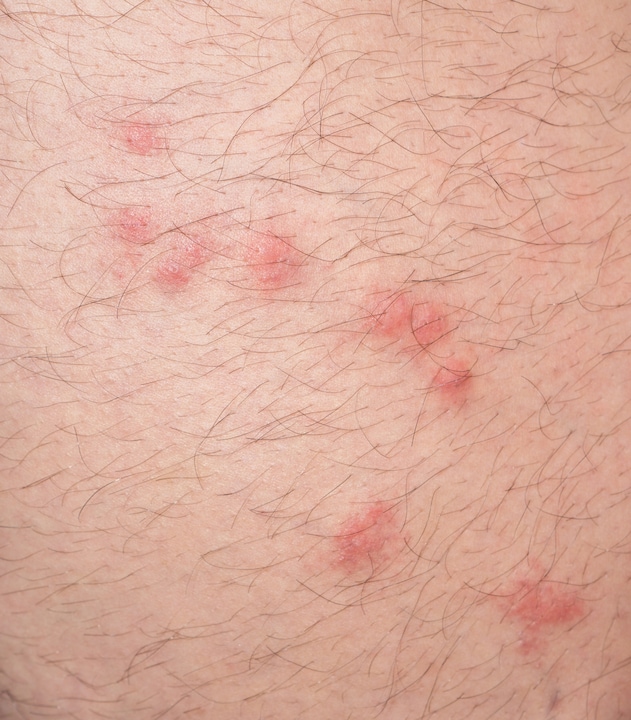"Human flea" is spreading in Berlin – how to recognize a bite

Berlin's foxes have a flea problem—and so do the two-legged residents of the capital. After all, fleas can jump to humans.
Foxes in the capital city are currently increasingly suffering from fleas. This has now prompted a task force of scientists to take action. To prevent the parasites from spreading to humans in the worst-case scenario, experts from the Leibniz Institute for Zoo and Wildlife Research (Leibniz-IZW) will research the spread of fleas and develop countermeasures, the institute announced.
According to the study, some flea species can infest other wild animals as well as domestic animals and humans. Particularly near fox dens, where flea eggs, larvae, and pupae develop, "transmission to humans may occur under certain circumstances." The so-called human flea, Pulex irritans , can also infest domestic cats, dogs, or foxes and survive on them.
In the capital, many foxes live close to humans, for example, near schoolyards or in parks and gardens. This makes it easier for them to jump to humans.
To date, at least seven cases of severe flea infestation have been reported near fox dens in various Berlin districts, including the southwest, west, and central districts. "However, it cannot be ruled out that this problem also exists in other parts of the city," the task force explained.
To eradicate the fleas, biologists, wildlife veterinarians, and advisory teams from the Leibniz-IZW are working closely with the Berlin Senate. This includes developing control strategies that are animal and species-friendly.
The use of special bait is currently being scientifically monitored. When an infested fox consumes it, the fleas die. The wild animal is then protected from flea infestation for several months, thus halting the spread of fleas.
The task force emphasizes that deterrence, i.e., keeping a wild animal away from a specific area, and the shooting of foxes are not under discussion. Shooting carries the risk that the vacated territories will be repopulated by new, possibly infested foxes. Deterrence could even promote the further spread of fleas.
Increased flea infestation is not a completely new phenomenon in Berlin, explains Silke Voigt-Heucke, coordinator of the "Fox & Flea" task force, in response to an inquiry from the Catholic News Agency (KNA). There is "anecdotal knowledge that there were cases last year as well." The task force is now scientifically monitoring the phenomenon for the first time.
Affected citizens can report their case from Monday to Friday between 10 a.m. and 12 p.m. via the advice line at 030/ 5168686 or by email at [email protected] .
Citizens are also encouraged to help researchers by sending in fleas for more precise identification. Anyone wishing to catch a flea should place it alive in a sealable container and then freeze it for at least 24 hours. The frozen flea should then be sent to a cooperating institute in a shatterproof container.
Kerstin Effers, an expert for environmental and health protection at the North Rhine-Westphalia Consumer Protection Center, describes the characteristics in an interview with the German Press Agency: "Flea bites can be recognized by their typical pattern: Often, several of the round, often bloody bites are found in a line, one behind the other."
If you discover flea bites on yourself, avoid scratching them, as this increases the risk of skin infections. To relieve the itching, you can cool the area – home remedies such as sliced onions, ribwort plantain, or cooling aloe vera gel are suitable. Special creams available at the pharmacy also help.

How to recognize an infestation in your pet and get rid of the parasites:
A simple way to determine if fleas are hiding: Comb the animal thoroughly on a light-colored cloth, preferably outside of your home. Flea droppings can be rubbed off with a damp cloth—unlike normal black crumbs. They also turn reddish-brown. Flea eggs can be seen as white dots in the fur.
Last but not least, the behavior of your four-legged friend provides information: If he grooms or scratches himself more frequently, this could indicate a flea infestation.
If you discover fleas in your pet's fur, the first step is to see a veterinarian. The best way to apply flea medication is directly to the pet—for example, as a spot-on product, which is applied to the neck fur.
Be careful when using: "For example, if you use tick and flea control products specifically designed for dogs on cats, you risk poisoning them," says Effers. If a dog and cat live in the same household, products containing the active ingredient permethrin should not be used.
Your four-legged friend's sleeping areas should be thoroughly vacuumed and cleaned. Washable bedding, pillows, blankets, and even toys should be washed at 60 degrees Celsius to kill pests.
Then it's the entire apartment's turn. Vacuum thoroughly or wipe with a damp cloth to ensure all flea larvae and pupae are removed. Important: Immediately afterward, take the vacuum cleaner bag outside and dispose of it. If your pet traveled in the car, please clean that area as well.
Sprays or foggers for use in the home are not recommended. They can contain substances that are harmful to humans through skin contact or inhalation. Furthermore, they cannot be easily removed.
FOCUS





